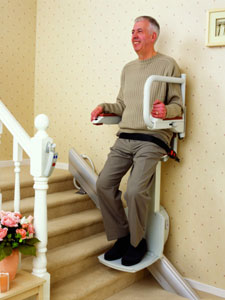Is a perch stairlift right for you?
If you have a narrow staircase an ideal solution to install a stairlift (also known as a 'stair chair') in your house could be to have a 'perch stairlift' (also called a 'perching stairlift'). I only said that it could be, because perch stairlifts are not ideal for everybody.
Before you decide to buy one, there are a few important things that you need to consider. But before I explain these, let's look at what a perch stairlift actually is.
What is a perch stairlift

A perch stairlift is a type of stairlift where instead of being seated you are stood up. In fact, on a perch stairlift you can either be leaning against a padded seat or 'perched' on a small seat (like on a bar stool). In both cases, your legs are more or less straight on the stairlift.
Like a normal seated stairlift, a perch stairlift has a foot rest/plate, a seat belt and either one or two armrests (depending on the model). With most perch stairlifts, these can folded up when not in use. The same as with a normal seated stairlift, the movement can be controlled by both a pushable switch on the armrest and by a remote control device.
They are narrower
Because you are not seated on the stairlift, it makes perch stairlifts narrower than traditional seated stairlifts. This combined with them being foldable, makes them ideal for narrow staircases.
But they are also taller
Because you are effectively stood up when moving on a perch stairlift, they can only be fitted if there is enough space between the person using it and the ceiling of the staircase (so people don't bang their heads). For most people and most staircases this will not be a problem. But if the person or people it is intended for are tall, it could be.
The only way you'll know for certain if this could be a problem for you, is to get a stairlift company to come out and assess your staircase for its suitability.
To find out about what things will decide if a stairlift can be fitted safely to your staircase, read my article on 'Is a stairlift possible on your stairs?'.
Support less weight
Because all the weight is placed on the foot rest/plate on a perch stairlift, they have a lower weight restriction than do traditional seated stairlifts. The average is around around 15-16 stone (210-224 pounds).
You should find out what the weight restriction is of a model of perch stairlift before you buy it.
Normally fitted to straight staircases
Most companies will only fit a perch stairlift to a straight set of stairs (where they can fit one straight track/rail). There are some companies which will fit a perch stairlift to a staircase which has a bend in it or is curved (where the stairlift uses a curved track/rail to move), but it is not very common.
Personally, I'm not sure that I would recommend that you have a perch stairlift on a curved track/rail. I think there could be some safety issues with using a perch stairlift on one.
Are safe
For straight stairs, perch stairlifts are just as safe as the traditional seated stairlift. On stairs which need a curved track/rail (used on staircases which have a bend in them or are curved), I don't think they are.
There is a risk of falling forward when the stairlift goes around the curve on the track. That explains why most stairlift manufacturers don't produce perch stairlifts for curved tracks/rails.
Who are they suitable for?
Perch stairlifts are not suitable for everybody. They are designed for people who have knee related problems (where bending them is painful). For other types of conditions (e.g. heart or breathing related, MS etc...) or if the person who will be using is very heavy, it is advisable to choose a traditional seated stairlift instead.
In addition, because of the standing up position on perch stairlifts, some people don't feel very safe or comfortable when using them.
See one in action
Below is a video of a perch stair lift being used.
Try one before you buy
I would strongly recommend that you try a perch stairlift before you buy one. As I mentioned before, some people don't feel safe or comfortable when using them. This is very important to know before you install one in your home.
If you don't know anybody who has one, most companies who sell and fit them will have demonstration models (either in the offices of the company or in the house of one of their customers). So ask them if you can try one.
Buying a hybrid
Some manufacturers sell stairlifts which combine both a standing position and a seated position (often called 'sit and stand'). In effect, they are a traditional seated stairlift which has been adapted to allow the person to also stand on them.
If you want to have both options, then this could be a good solution for you.
The downside of these hybrid stairlifts is that they are not as narrow as a perch stairlift. So if your staircase is narrow, they may not be able to fit one.
In conclusion
For some people a perch stairlift is an ideal option to go for (especially if you have a narrow staircase where a seated stairlift won't fit). But they are not suitable for everyone. For certain medical conditions, a traditional seated stairlift is by far the best option. Even if such a medical condition doesn't affect you, some people don't feel comfortable moving on stairlift basically stood up.
So before you spend your money on one, I strongly urge you to give one a try. That's the only way to know if it's the right option for you or not.
Who to buy a stairlift from
Click on one of the flags below to see a list of reputable companies in that country that you can buy a stairlift from and who they are:




